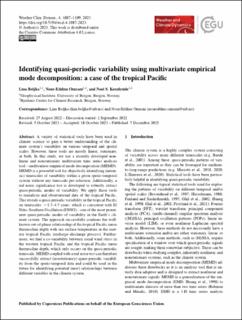| dc.contributor.author | Boljka, Lina | |
| dc.contributor.author | Omrani, Nour-Eddine | |
| dc.contributor.author | Keenlyside, Noel Sebastian | |
| dc.date.accessioned | 2024-03-25T09:51:31Z | |
| dc.date.available | 2024-03-25T09:51:31Z | |
| dc.date.created | 2023-11-30T02:41:14Z | |
| dc.date.issued | 2023 | |
| dc.identifier.issn | 2698-4016 | |
| dc.identifier.uri | https://hdl.handle.net/11250/3124027 | |
| dc.description.abstract | A variety of statistical tools have been used in climate science to gain a better understanding of the climate system's variability on various temporal and spatial scales. However, these tools are mostly linear, stationary, or both. In this study, we use a recently developed nonlinear and nonstationary multivariate time series analysis tool – multivariate empirical mode decomposition (MEMD). MEMD is a powerful tool for objectively identifying (intrinsic) timescales of variability within a given spatio-temporal system without any timescale pre-selection. Additionally, a red noise significance test is developed to robustly extract quasi-periodic modes of variability. We apply these tools to reanalysis and observational data of the tropical Pacific. This reveals a quasi-periodic variability in the tropical Pacific on timescales ∼ 1.5–4.5 years, which is consistent with El Niño–Southern Oscillation (ENSO) – one of the most prominent quasi-periodic modes of variability in the Earth’s climate system. The approach successfully confirms the well-known out-of-phase relationship of the tropical Pacific mean thermocline depth with sea surface temperature in the eastern tropical Pacific (recharge–discharge process). Furthermore, we find a co-variability between zonal wind stress in the western tropical Pacific and the tropical Pacific mean thermocline depth, which only occurs on the quasi-periodic timescale. MEMD coupled with a red noise test can therefore successfully extract (nonstationary) quasi-periodic variability from the spatio-temporal data and could be used in the future for identifying potential (new) relationships between different variables in the climate system. | en_US |
| dc.language.iso | eng | en_US |
| dc.publisher | Copernicus Publications | en_US |
| dc.rights | Navngivelse 4.0 Internasjonal | * |
| dc.rights.uri | http://creativecommons.org/licenses/by/4.0/deed.no | * |
| dc.title | Identifying quasi-periodic variability using multivariate empirical mode decomposition: a case of the tropical Pacific | en_US |
| dc.type | Journal article | en_US |
| dc.type | Peer reviewed | en_US |
| dc.description.version | publishedVersion | en_US |
| dc.rights.holder | Copyright 2023 The Author(s) | en_US |
| cristin.ispublished | false | |
| cristin.fulltext | original | |
| cristin.qualitycode | 1 | |
| dc.identifier.doi | 10.5194/wcd-4-1087-2023 | |
| dc.identifier.cristin | 2205841 | |
| dc.source.journal | Weather and Climate Dynamics (WCD) | en_US |
| dc.source.pagenumber | 1087-1109 | en_US |
| dc.relation.project | Trond Mohn stiftelse: BFS2018TMT01 | en_US |
| dc.relation.project | Norges forskningsråd: 316618 | en_US |
| dc.relation.project | Sigma2: ns9039K | en_US |
| dc.relation.project | Norges forskningsråd: 312017 | en_US |
| dc.identifier.citation | Weather and Climate Dynamics (WCD). 2023, 4 (4), 1087-1109. | en_US |
| dc.source.volume | 4 | en_US |
| dc.source.issue | 4 | en_US |

